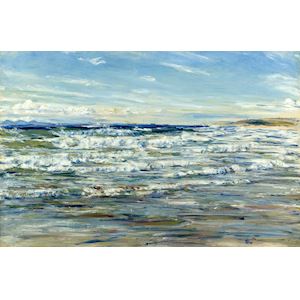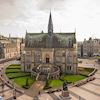
17. AND ALL THE CHORAL WATERS SANG, WILLIAM McTAGGART IN THE VICTORIA GALLERY
This painting, titled And All the Choral Waters Sang, was completed in 1902 by the artist William McTaggart. McTaggart is known for his coastal paintings, which often include children. This late work is unusual in that it contains no figures. Imagine seeing McTaggart painting this outdoors, on the beach at Machrihanish. It’s a three-mile stretch of sand near his birthplace of Campbeltown on Scotland’s West coast. The huge canvas was weighted with rocks so as not to fly away! The descriptive title, And All the Choral Waters Sang, is a quotation from a poem by the Romantic Victorian author Swinburne. McTaggart is a fascinating Scottish artist. Look at the broad, loose brushwork in this painting. When critics first saw the work, they were shocked that the paint was so loosely applied, and that areas of primed canvas were visible. There’s much debate about whether or not McTaggart’s ‘impressionistic’ style was influenced by the French impressionists. It’s more likely that he discovered his broad paint handling technique on his own. Here’s a description of the painting from 1917: “Looking north-west, the radiant early afternoon sunshine of June falls upon the ordered on-rush of these charging regiments of rearing and plunging white horses sweeping into the long curving bay, and raising their white foaming manes and flying silver tails to a brilliance greater than that of sun-illumined snow. And, between the gleaming lines of racing white, the wind-swept sky throws reflections of vivid changing blues, which, mingling with the lustrous greens amid the leaping waves and the rosy purples and tawnies afloat in the shoreward shooting ripples, make a powerful and potent harmony. Words, however, are woefully inadequate to convey any real impression of this splendid picture - this great sea symphony in colour and light and movement."
To hear a short passage from the poem that inspired this painting, press the A button on your player, now.


The McManus: Dundee's Art Gallery and Museum
The McManus: Dundee’s Art Gallery and Museum is situated in the centre of Dundee. The Museum and Art Gallery originally known as the Albert Institute was opened in 1867 as a memorial to Prince Albert. In 2005 The McManus closed for a major refurbishment, reopening again on the 28th February 2010. We celebrated our 150th Anniversay in 2017 with a year of celebration. In 2020 we were awarded Visitor Attraction of the Year by Visit Scotland. The McManus has 8 galleries, which are laid out on 2 floors. Visitors can embark on a journey through 400 million years, and witness how a small settlement developed into the City of Dundee as it is today. From exhibits relating to the life of early man in the area, stunning paintings and decorative art through to artefacts from industries past and present, the City's collections, many of which are recognised as being of national significance, give an insight into Dundee and its people.
- The McManus: Dundee's Art Gallery and Museum
- Dundee United Kingdom
- www.mcmanus.co.uk
